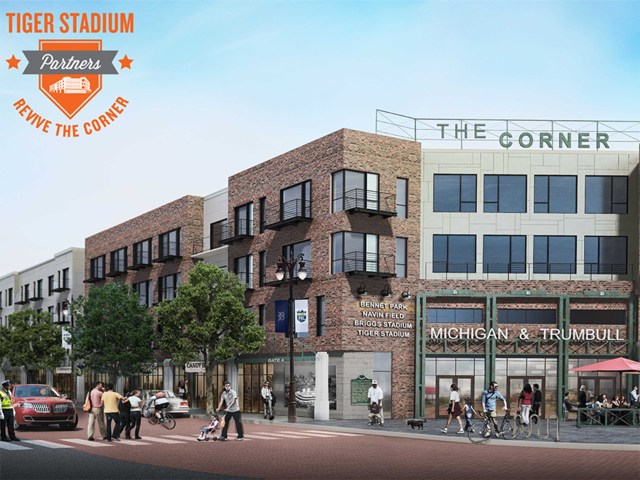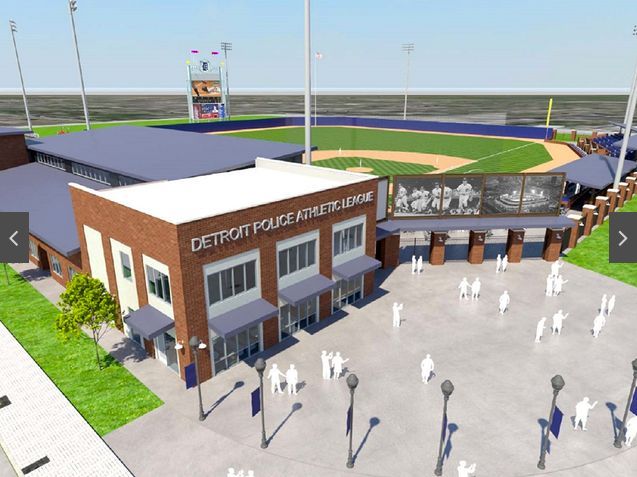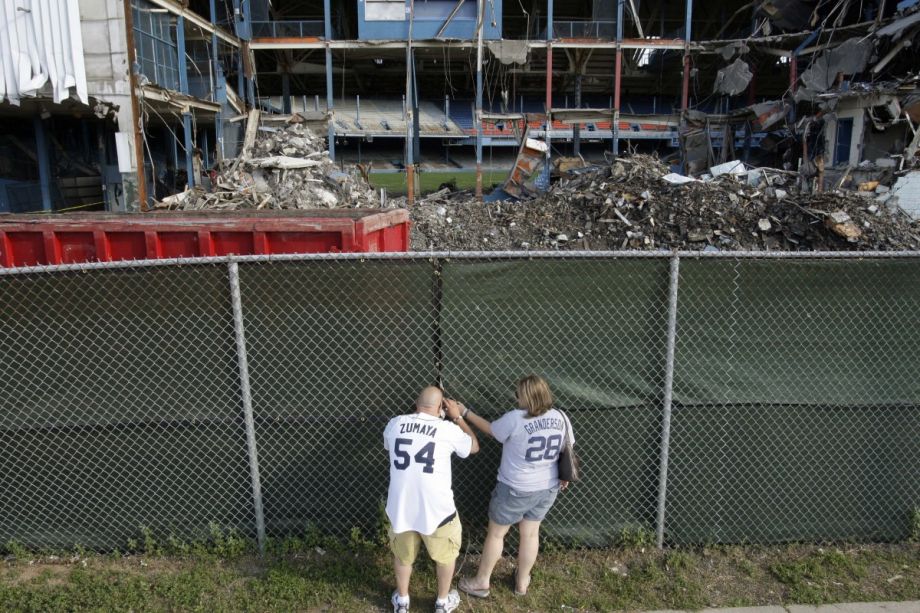Don’t call the Corner “vacant.” The intersection of Michigan and Trumbull in Detroit’s Corktown is anything but empty.
Here, you’ll find 10 acres of grass and infield, with a 125-foot flagpole standing tall in center field. Detroiters call it “old Tiger Stadium,” even though the ballpark is only a ghost now. The team began playing there in 1896, and opened its new park in 1912, the same day as Boston’s Fenway Park. After nearly nine decades of hope, grief and triumph, the Tigers played their final game at the park in 1999, finishing, as only poetry and baseball can, with a rooftop grand slam for the home team.
From public financing to urban design, U.S. cities have a famously complicated affair with sports stadiums. It doesn’t get easier when stadiums are “retired” — if they don’t become an abandoned mess, they can become a battleground between preservation and redevelopment interests, and public and private sectors. The result is a sometimes uneasy compromise.
In Indianapolis, Bush Stadium went through iterations as a speedway and a “cash for clunkers” site before becoming condos only a few portions of the historic park are preserved. More appealing, in New York, old Yankee Stadium is now parkland and all-weather recreational facilities serving the South Bronx.
Detroit’s old white-and-blue stadium sat stagnant for more than a decade as preservation efforts were floated, then flamed out. Tiger Stadium was torn down five years ago. Between the Great Recession and emotionally entangled competing interests, redevelopment discussions stalled — until this month.
The Detroit Economic Growth Corporation approved a $33 million mixed-use redevelopment plan that will preserve the field for youth baseball and build street-facing retail/residential space. It now goes to City Council for the final stamp of approval.
It is encouraging that the plan connects the Corner’s historic past with Detroit’s revitalized future. But it also shouldn’t overlook what is right here, right now. With a few adjustments, a good redevelopment plan can become a great one.
In one of the most famous iterations of Detroit’s do-it-yourself spirit, a clutch of fans adopted the old park in 2010. The Navin Field Grounds Crew — a name recalling Tiger Stadium’s original moniker — mows the grass, maintains the field with bases and painted lines, and keeps the space alive as an active ballpark open for all. Historical plays are re-enacted, like a live-action highlights reel. The crew celebrated “Willie Horton Day” on the occasion of the Tigers star’s birthday, with a game of hardball followed by cake cut in left field (where Horton played). Old-time baseball teams play there, as do Detroit kids and Little Leaguers. On the infield, people marry and spread their ashes. Tourists come from all over the world to pay respects to the stadium, to work alongside the grounds crew and to play a little ball. You can come over, too, if you want.
Navin Field volunteers are trespassers: You have to sidle through the fence to enter. But the good they’ve done is obvious. If it weren’t for them, the site might be a vast overgrown lot of six-foot-high weeds and mountains of garbage. Instead, the corner where Detroiters long gathered as family is still a place of joy.
Developers should integrate the best that’s come out of the Navin Field experiment into their plan.

(Credit: Larson Realty Group)
To finance the project, developers will take the unusual step of trying to raise 10 percent — about $400,000 — through crowdfunding. This is designed so that Detroiters can take ownership of the project through small investments.
Altogether, this is an inclusive and exciting plan. But here’s how it could be even better:
As it stands, the plan will privatize the baseball field. Only PAL teams will play on it, in contrast with the open-door policy of the Navin Field Grounds Crew. It is reasonable for PAL teams to have priority on the redeveloped field, but the public should be able to enjoy it in off hours.

(Credit: Detroit PAL
Old Yankee Stadium offers a model of how to preserve natural grass in a publicly accessible park. Preserving natural-grass playing fields went a long way in building good will in a community that had grown bitter over stadium developments. But once the revived field opened, it won over even its longstanding critics. As one opponent of the New York project put it, “I figured they were going to pull a fast one and give us a little corner somewhere. But they’ve made a believer out of me.”
If PAL is concerned about upkeep of natural grass, it should take note of how the community values it so much — volunteers already freely offer their time and tools to maintain it. PAL can leverage existing partnerships to make natural grass a sustainable long-term plan.
Altogether, redevelopment of the old Tigers ballpark is off to a promising start. But there’s no reason that Detroiters can’t, for once, expect the best. As much as the Navin Field Grounds Crew is reviving the history of the site, they have also created a model for what we might see in our future: playful, reverent and open to all.

Anna Clark is a journalist in Detroit. Her writing has appeared in Elle Magazine, the New York Times, Politico, the Columbia Journalism Review, Next City and other publications. Anna edited A Detroit Anthology, a Michigan Notable Book. She has been a Fulbright fellow in Nairobi, Kenya and a Knight-Wallace journalism fellow at the University of Michigan. She is also the author of THE POISONED CITY: Flint’s Water and the American Urban Tragedy, published by Metropolitan Books in 2018.
Follow Anna .(JavaScript must be enabled to view this email address)
















